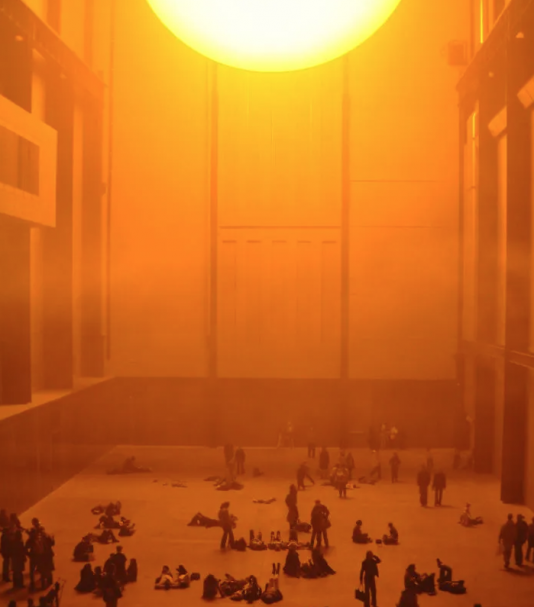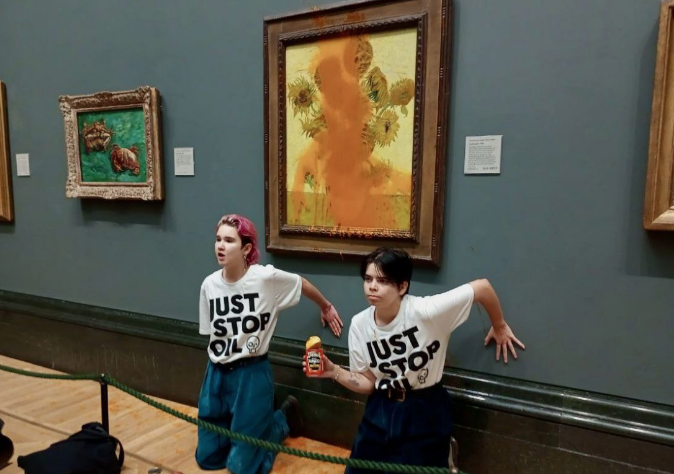In mid-October, van Gogh’s ‘Sunflowers’ were attacked by canned soup at the National Gallery in London.
Trafalgar Square and the art world were up in arms. Art lovers from afar were devastated. Some radical environmentalists relished. The jury was out on the group responsible for the act, Just Stop Oil, asking whether damaging the work of an artist who adored nature and people, was necessary.
🥫 JUST STOP OIL SUPPORTERS CHOOSE LIFE OVER ART 🥫
🎨 Human creativity and brilliance is on show in this gallery, yet our heritage is being destroyed by our Government’s failure to act on the climate and cost of living crisis.#VanGogh #FreeLouis #FreeJosh #CivilResistance pic.twitter.com/gXXGLsi0ej
— Just Stop Oil ⚖️💀🛢 (@JustStop_Oil) October 14, 2022
Then reports surfaced that another painting had faced a side dish’s wrath, sparking the ‘is it necessary’ debate yet again.
This time, Claude Monet’s ‘Meules’ almost earned collateral damage status at the hands of German environmentalists. No tomato soup made the headlines this time; mashed potatoes carried the rage of the Letzte Generation (Last Generation).
Luckily for ‘Mueles’ fans, the painting is paneled in glass and, according to the Museum Barberini, had suffered no damage.
Still, the lack of damage shouldn’t be the point. The point is the message that needed tomato soup and mashed potatoes to carry it… but carry it where?
“Does it take mashed potatoes on a painting to make you listen?” asked one of the activists in a clip shared by the group.
We make this #Monet the stage and the public the audience.
If it takes a painting – with #MashedPotatoes or #TomatoSoup thrown at it – to make society remember that the fossil fuel course is killing us all:
Then we’ll give you #MashedPotatoes on a painting! pic.twitter.com/HBeZL69QTZ
— Letzte Generation (@AufstandLastGen) October 23, 2022
A crucial question at first glance, but a fallacy below the surface.
Art is the wrong target
I will never and can never justify the acts of those who blatantly ignore climate change. Or those who regard our planet with about as much concern as half-heartedly written email.
However, looking at these moments of civic action from the perspective of someone who cares actively and deeply about the climate change crisis, I also can’t justify the actions of the Just Stop Oil and Last Generation activists. Many people stand in the same position as me — as an art and earth lover. After all, doesn’t the cliche eco-art quote remind us that the earth without art is just ‘eh?’
For as long as art has channelled human emotion and helped us make sense of the world, nature has been its purest source of inspiration.
Especially in the impressionist and post-impressionist eras — of which Monet and Van Gogh are celebrated respectively — nature was the guiding force of artworks.
This is not to say that because an artist from bygone eras created a work inspired by daffodils, they may be credited as an environmentalist. Rather, it highlights that art has long held a role in facilitating the audience’s appreciation for nature through their eyes. And to care about something, we must first appreciate it.
Art and activism are old friends. They work best in this kind of relationship, feeding into each other. Think of the power 90s and early 2000s art movements had with their clever and aesthetic navigation in raising awareness for concepts like global warming, which as Olaf Eliasson, the artist behind 2003’s ‘The Weather Project’, reminds us were only ‘professional terminology’ at the time, not mainstream as they are today.

Olafur Eliasson – The Weather Project, 2003
The Weather Project saw Tate Modern’s Turbine Hall filled with a ‘half sun’ using intricate materials and curious light tricks to recreate the weather indoors and bring it to our focal point. It was revisited in 2019 with the same message, just deeper urgency.
In the modern day, the likes of Andrea Polli, Benjamin Von Wong and Gavin Turk are all classified under environmental art. Sometimes they are called activists themselves.
If art and environmentalism have had such an intertwined relationship over the years, you’d be forgiven for finding it ironic to attack the works of Monet and van Gogh, artists who have often been praised by environmentalists for their deep appreciation of nature.
But the point was the irony.
Attacking nature-celebrating works, I believe, were meant to symbolise that this is what will happen to the planet. The art is the earth. The soup is the crisis and those who allowed it.
A devastating message but one that misses its mark.
If the target was the wealthy, the dons of capitalism who are often synonymous with art elitism, the message is almost more bearable. Almost. Still, I disagree with the logic that this would shake CEOs of oil companies enough to stop their regular business proceedings. If anything, it drove a wedge between eco-warriors and art-loving environmentalists.
And for the general public, the majority of what it achieved was confusion and anger.
The emotions the activists who used food sources as weapons against art are high. They represent many of us who, as younger people, are genuinely terrified of what our world might look like – a world that most of the perpetrators of climate turmoil will never see.
Still, the crossing of the line also crossed a relationship between two groups (artists and environmentalists) in a way that weakens the most important element of any protest – community.
ALSO SEE:
Feature Image: Just Stop Oil

